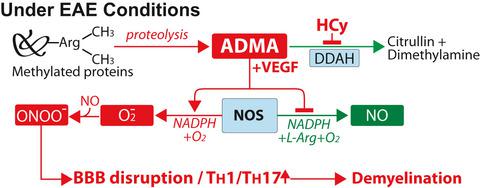当前位置:
X-MOL 学术
›
Immunology
›
论文详情
Our official English website, www.x-mol.net, welcomes your feedback! (Note: you will need to create a separate account there.)
Vascular and immunopathological role of Asymmetric Dimethylarginine (ADMA) in Experimental Autoimmune Encephalomyelitis
Immunology ( IF 6.4 ) Pub Date : 2021-07-26 , DOI: 10.1111/imm.13396 Inderjit Singh 1, 2 , Judong Kim 1 , Nishant Saxena 1 , Seungho Choi 1 , S M Touhidul Islam 1 , Avtar K Singh 3, 4 , Mushfiquddin Khan 1 , Jeseong Won 3
Immunology ( IF 6.4 ) Pub Date : 2021-07-26 , DOI: 10.1111/imm.13396 Inderjit Singh 1, 2 , Judong Kim 1 , Nishant Saxena 1 , Seungho Choi 1 , S M Touhidul Islam 1 , Avtar K Singh 3, 4 , Mushfiquddin Khan 1 , Jeseong Won 3
Affiliation

|
Asymmetric dimethylarginine (ADMA) is an endogenous nitric oxide synthase (NOS) inhibitor/uncoupler inducing vascular pathology. Vascular pathology is an important factor for the development and progression of CNS pathology of MS, yet the role of ADMA in MS remains elusive. Patients with multiple sclerosis (MS) are reported to have elevated blood levels of ADMA, and mice with experimental autoimmune encephalomyelitis (EAE, an animal model of MS) generated by auto-immunization of myelin oligodendrocyte glycoprotein (MOG) and blood–brain barrier (BBB) disruption by pertussis toxin also had increased blood ADMA levels in parallel with induction of clinical disease. To explore the role of ADMA in EAE pathogenesis, EAE mice were treated with a daily dose of ADMA. It is of special interest that ADMA treatment enhanced the BBB disruption in EAE mice and exacerbated the clinical and CNS disease of EAE. ADMA treatment also induced the BBB disruption and EAE disease in MOG-immunized mice even without pertussis toxin treatment, suggesting the role of ADMA in BBB dysfunction in EAE. T-cell polarization studies also documented that ADMA treatment promotes TH1- and TH17-mediated immune responses but without affecting Treg-mediated immune response in EAE mice as well as in in vitro T-cell culture. Taken together, these data, for the first time, document the vascular and immunopathogenic roles of ADMA in EAE, thus pointing to the potential of ADMA-mediated mechanism as a new target of potential therapy for MS.
中文翻译:

不对称二甲基精氨酸 (ADMA) 在实验性自身免疫性脑脊髓炎中的血管和免疫病理学作用
不对称二甲基精氨酸 (ADMA) 是一种内源性一氧化氮合酶 (NOS) 抑制剂/解偶联剂,可诱导血管病变。血管病变是 MS 中枢神经系统病变发展和进展的重要因素,但 ADMA 在 MS 中的作用仍不清楚。据报道,多发性硬化症 (MS) 患者的血液中 ADMA 水平升高,而患有实验性自身免疫性脑脊髓炎 (EAE,MS 的动物模型) 的小鼠由髓鞘少突胶质细胞糖蛋白 (MOG) 和血脑屏障的自身免疫产生。 BBB) 百日咳毒素的破坏也增加了血液 ADMA 水平,同时诱发了临床疾病。为了探索 ADMA 在 EAE 发病机制中的作用,EAE 小鼠接受了每日剂量的 ADMA 治疗。特别令人感兴趣的是,ADMA 治疗增强了 EAE 小鼠的 BBB 破坏并加剧了 EAE 的临床和中枢神经系统疾病。即使没有百日咳毒素治疗,ADMA 治疗也诱导 MOG 免疫小鼠的 BBB 破坏和 EAE 疾病,这表明 ADMA 在 EAE 中 BBB 功能障碍中的作用。T 细胞极化研究还证明 ADMA 治疗可促进 TH 1 和 T H 17 介导的免疫反应,但不影响 EAE 小鼠以及体外 T 细胞培养物中 Treg 介导的免疫反应。总之,这些数据首次记录了 ADMA 在 EAE 中的血管和免疫致病作用,从而指出 ADMA 介导机制作为 MS 潜在治疗新靶点的潜力。
更新日期:2021-07-26
中文翻译:

不对称二甲基精氨酸 (ADMA) 在实验性自身免疫性脑脊髓炎中的血管和免疫病理学作用
不对称二甲基精氨酸 (ADMA) 是一种内源性一氧化氮合酶 (NOS) 抑制剂/解偶联剂,可诱导血管病变。血管病变是 MS 中枢神经系统病变发展和进展的重要因素,但 ADMA 在 MS 中的作用仍不清楚。据报道,多发性硬化症 (MS) 患者的血液中 ADMA 水平升高,而患有实验性自身免疫性脑脊髓炎 (EAE,MS 的动物模型) 的小鼠由髓鞘少突胶质细胞糖蛋白 (MOG) 和血脑屏障的自身免疫产生。 BBB) 百日咳毒素的破坏也增加了血液 ADMA 水平,同时诱发了临床疾病。为了探索 ADMA 在 EAE 发病机制中的作用,EAE 小鼠接受了每日剂量的 ADMA 治疗。特别令人感兴趣的是,ADMA 治疗增强了 EAE 小鼠的 BBB 破坏并加剧了 EAE 的临床和中枢神经系统疾病。即使没有百日咳毒素治疗,ADMA 治疗也诱导 MOG 免疫小鼠的 BBB 破坏和 EAE 疾病,这表明 ADMA 在 EAE 中 BBB 功能障碍中的作用。T 细胞极化研究还证明 ADMA 治疗可促进 TH 1 和 T H 17 介导的免疫反应,但不影响 EAE 小鼠以及体外 T 细胞培养物中 Treg 介导的免疫反应。总之,这些数据首次记录了 ADMA 在 EAE 中的血管和免疫致病作用,从而指出 ADMA 介导机制作为 MS 潜在治疗新靶点的潜力。


























 京公网安备 11010802027423号
京公网安备 11010802027423号